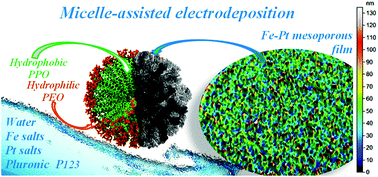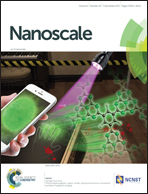Micelle-assisted electrodeposition of highly mesoporous Fe–Pt nodular films with soft magnetic and electrocatalytic properties†
Abstract
Mesoporous Fe–Pt nodular films (with a regular spatial arrangement of sub-15 nm pores) are grown onto evaporated Au, Cu and Al conductive layers by micelle-assisted electrodeposition from metal chloride salts in the presence of Pluronic P123 tri-block copolymer dissolved in the aqueous electrolytic bath. This synthetic approach constitutes a simple, one-step, versatile procedure to grow multifunctional mesoporous layers appealing for diverse applications that take advantage of materials with an ultra-high surface area-to-volume ratio. The films exhibit tuneable composition with relative Fe/Pt weight ratios, disregarding oxygen, varying from 4/96 to 52/48. All the mesoporous alloys show a soft magnetic behaviour with tuneable saturation magnetization and coercivity values (the latter ranging from ca. 5 Oe to 40 Oe). In addition, the Au/Fe–Pt deposits (even the ones with higher Fe content) exhibit good performance towards hydrogen evolution reaction in both alkaline and acidic media due to the inherent mesoporosity, with excellent stability after running 50 cycles. The interest of alloying Fe with Pt is thus two-fold: (i) to confer magnetic properties to the mesoporous alloys and (ii) to reduce the amount of the costly noble metal in the electrocatalyst in an environmentally sustainable manner.



 Please wait while we load your content...
Please wait while we load your content...